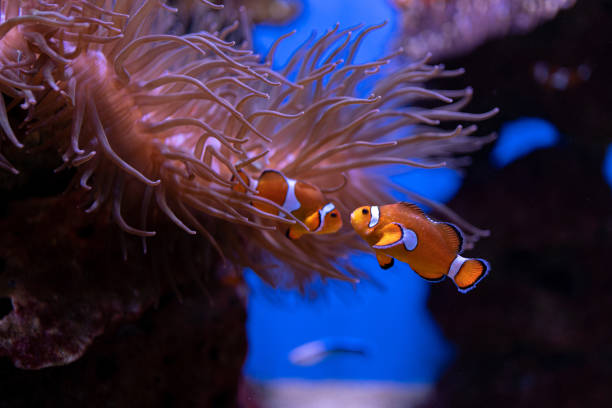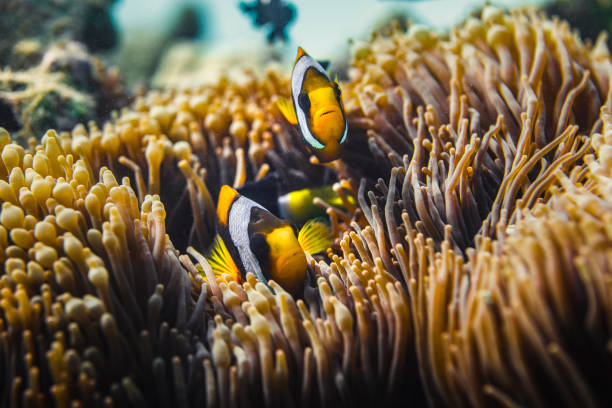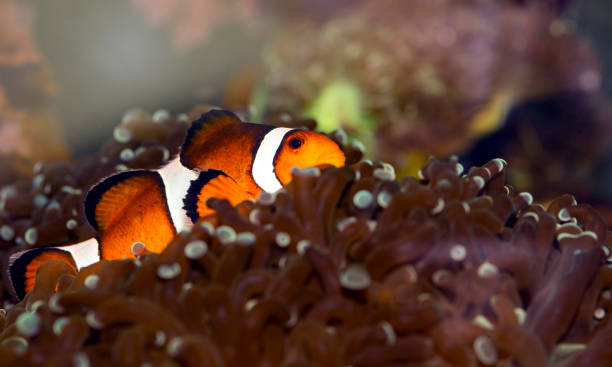Are Clownfish Good Pets: How to Take Care of Pet Clownfish
Clownfish are native to the Indo-Pacific region and can be found in both tropical and temperate waters. They are typically found near coral reefs and can be found in a variety of colors, including pink, yellow, and orange.
Clownfish are often considered good pets because of their playful and fun personalities. They are also relatively easy to take care of, as they do not require a lot of water or food. They are peaceful fish and make good pets. However, there are still aquarium requirements that you should take note of to make sure that they will receive their needs in captivity.

Table of Contents
Clownfish Overview
Appearance and Size
Clownfish are a type of fish that are known for their colorful and expressive appearances. They typically have a brightly-colored body with a distinctive pattern on their head. Clownfish are also known for their playful and entertaining behavior, which makes them an ideal pet choice for those who enjoy interacting with other animals. Clownfish can vary in size from small to large. The most common size for a clownfish is about 3.5 inches long, but they can grow up to 4.3 inches long.
Lifespan
Clownfish typically live for around 3 to 10 years in captivity. However, the lifespan of a clownfish varies depending on the individual and can be significantly longer or shorter if they are kept in healthy conditions.
Typical Behavior
Clownfish are typically active during the day and become more inactive at night. They enjoy swimming around and entertaining themselves with interesting movements and antics. clownfish will also get along well with other fish in an aquarium but should be kept apart from other aggressive tank mates. Clownfish can be quite playful and will enjoy playing with other fish or toys.

Aquarium Requirements for Pet Clownfish
Aquarium Size
Clownfish can be housed in a tank that is small or large, but they require at least 10 gallons of water to feel comfortable. They are also very active and will swim around quickly so make sure the tank has plenty of space to accommodate their needs. Aquariums with higher water levels tend to be more ideal for clownfish as they can swim further away from predators.
Aquarium Conditions
Clownfish are adaptable fish and can handle a wide range of tank conditions, but they do best in tanks with a temperature range of 76-82 degrees Fahrenheit (25-28 degrees Celsius) and a pH range of 8.0-8.4. They also enjoy plenty of hiding places and plants to explore, as well as enough room to swim around.
Tankmates
Many clownfish tank mates can be chosen for a clownfish tank. Some popular choices include plecos, anemones, damsels, and dwarf gouramis. It is important to choose a clownfish tank mate that is compatible with the size of the tank and the personality of the clownfish. On a different note, keeping clownfish together can be a challenge. They are active and playful fish and need plenty of room to swim around. If you have more than one clownfish, it is best to keep them in separate tanks.
Food and Diet
Clownfish are omnivorous fish and will eat small fishes, crustaceans, and plant matter. They prefer a diet of live food, but will also eat frozen or artificial foods. A clownfish diet consists largely of small fish, but they will also eat crustaceans, algae, and other plants.
Overall Care
Clownfish are one of the more popular fish in the pet trade, but they can also be a little challenging to care for. Here are some tips on how to keep your clownfish healthy and happy:
- Provide plenty of clean, fresh water in a tank that is large enough for your clownfish to swim around in. Clownfish like to swim and play, so they need plenty of space.
- Feed your clownfish live food such as small fish or shrimp once a day. Do not overfeed them as this can lead to obesity and health problems.
- Keep the tank clean by removing any debris such as leaves or plants that may accumulate over time. Use an aquarium cleaner if necessary.
Breeding
There is no easy way to breed clownfish, but it is possible with a little patience and effort. Clownfish are hardy fish and do not need an elaborate or expensive breeding tank setup. A basic 12-inch tank filled with live rock adequate for the size of your clownfish will work fine. It is also important to provide plenty of hiding places for the male and female clowns as they will want to mate in privacy.

How Much Does a Pet Clownfish Cost?
A pet clownfish can cost anywhere from $10 to $100, but the average price is about $10-$25. Clownfish are considered good pets because they are easy to care for and they make great additions to any aquarium.
Types of Pet Clownfish
Several different types of clownfish can be found in the wild or captivity. Here is a list of some of the most popular ones:
- Common Clownfish
- True Percula Clownfish
- Cinnamon Clownfish
- Tomato Clownfish
- Maroon Clownfish
- Clarkii Clownfish
- Pink Skunk Clownfish
- Saddleback Clownfish